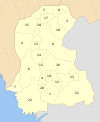Karachi District (South)
Karachi District
ضلع کراچی | |
|---|---|
Clockwise from top-left: Old Karachi Municipal Corporation, I. I. Chundrigar Road, Frere Hall, View of Mazar-e-Quaid, National Museum of Pakistan | |
 Map of Karachi District | |
| Country | |
| Province | |
| Division | Karachi |
| Established | 1972 |
| Re-established | 11 July 2011 |
| Headquarters[1] | Saddar Town |
| Boroughs | |
| Government | |
| • Deputy Commissioner | Altaf Hussain Sario[3] |
| Area | |
| • Total | 122 km2 (47 sq mi) |
| Population | |
| • Total | 2,329,764 |
| • Density | 19,000/km2 (49,000/sq mi) |
| Website | dmcsouth |
Karachi District (formerly Karachi South District)(Urdu: ضلع کراچی) is an administrative district of Karachi Division in Sindh, Pakistan.[5][6]
In 2023, the Government of Sindh renamed Karachi South District simply to Karachi District because all divisional administration is located there.[7]
History
[edit]Karachi South District is the economic backbone of the country. It has the Head Offices of many Corporations, Companies and Banks. The Chief Secretary House, Governor House, Chief Minister House, Commissioner House, Commissioner Office, Sindh Assembly, High Court, Embassies and Consulates of different countries and other government offices are also located there.
The district was abolished in 2000, and was divided into two towns namely: Jamshed Town, and Saddar Town.
On 11 July 2011, the Sindh Government restored Karachi South District.[8]
In November 2013, Jamshed Town was added into Karachi East District, after three eastern towns of that district split up to form a new district named Korangi. Now Karachi South comprise Saddar along with Clifton and Defence area. Karachi South is considered to be the most affluent area of the city.
In 2022, it was divided into two towns namely Saddar Town and Lyari Town.[9]
In 2023, the Sindh Government renamed Karachi South District to Karachi District.
Demographics
[edit]At the time of the 2017 census, Karachi South had a sex ratio of 901 females per 1000 males and a literacy rate of 77.79%: 79.98% for males and 75.33% for females. The entire population lived in urban areas. 358,672 (20.27%) were under 10 years of age.[10] In 2023, the district had 426,224 households and a population of 2,329,764.[4]
The majority religion is Islam, with 93.85% of the population. Hinduism (including Scheduled Castes) is practiced by 4.24% and Christianity by 1.65% of the population.[12]
At the time of the 2023 census, 34.7% of the population spoke Urdu, 15.62% Sindhi, 11.58% Balochi, 9.42% Pashto, 8.17% Punjabi, 3.71% Hindko and 2.64% Saraiki as their first language. A large percentage of the population speaks languages recorded as 'Other' on the census, such as Gujarati.[13]
Administrative Towns of Karachi South
[edit]Following is the list of two administrative towns of Karachi South District.[14]
| Union Council |
|---|
| U.C. 1 Ghanchi Para |
| U.C. 2 Hasan Lashkari Village |
| U.C. 3 Garden |
| U.C. 4 Millat Nagar |
| U.C. 5 Gazdarabad |
| U.C. 6 Nanak Wara |
| U.C. 7 Old Town Kharadar |
| U.C. 8 City Railway Colony |
| U.C. 9 Saddar |
| U.C. 10 Hijrat Colony |
| U.C. 11 Frere Town |
| U.C. 12 Boat Basin |
| U.C. 13 Clifton - Kehkashan |
| Union Council |
|---|
| U.C. 1 Agra Taj Colony |
| U.C. 2 Bihar Colony |
| U.C. 3 Gulshan Colony |
| U.C. 4 Singo Lane |
| U.C. 5 Nawa Lane |
| U.C. 6 Kalakot - Rexer Lanes |
| U.C. 7 Ghulam Muhammad Lane - Ragiwara |
| U.C. 8 Kalari - Shah Baig Line |
| U.C. 9 Daryaabad - Hingorabad |
| U.C. 10 Khadda Memon Society |
| U.C. 11 Nayaabad |
| U.C. 12 Baghdadi |
| U.C. 13 Jinnahabad - Ghulam Shah Lane |
See also
[edit]References
[edit]- ^ "ADMINISTRATIVE DISTRICTS". Commissioner, Karachi Division.
- ^ "Karachi to have 26 towns, 233 union bodies under Sindh LG Act". Business Recorder (newspaper). 9 January 2022. Retrieved 22 January 2023.
- ^ "Usman Club clinch DC South Basketball Championship trophy". The Nation (newspaper). 8 December 2023. Retrieved 31 December 2023.
- ^ a b "TABLE 1 : HOUSEHOLDS, POPULATION, HOUSEHOLD SIZE AND ANNUAL GROWTH RATE" (PDF). www.pbscensus.gov.pk. Pakistan Bureau of Statistics. 2023.
- ^ "Imperial Gazetteer2 of India, Volume 15, page 1 -- Imperial Gazetteer of India -- Digital South Asia Library". dsal.uchicago.edu. Retrieved 2 August 2024.
- ^ "Imperial Gazetteer2 of India, Volume 15, page 8 -- Imperial Gazetteer of India -- Digital South Asia Library". dsal.uchicago.edu. Retrieved 2 August 2024.
- ^ "Four Karachi districts to be renamed". 29 March 2024. Retrieved 4 April 2024.
- ^ Karachi's district status restored, notification issued, Published in The News Tribe on 11 July 2011, Retrieved on 22 August 2012
- ^ Tahir Siddiqui (8 January 2022). "Division of Karachi into 26 towns, 233 UCs notified (by the government)". Dawn (newspaper). Retrieved 17 January 2022.
- ^ "District Wise Results / Tables (Census - 2017)". www.pbscensus.gov.pk. Pakistan Bureau of Statistics.
- ^ "District Wise Results / Tables (Census - 2023)" (PDF). www.pbscensus.gov.pk. Pakistan Bureau of Statistics.
- ^ "Pakistan Census 2023" (PDF).
- ^ "Pakistan Census 2023" (PDF).
- ^ "Division of UCs in Karachi - Notification" (PDF). lgdsindh.gov.pk. Local Government & Housing Town Planning Department - Government of Sindh. 27 April 2023. Retrieved 29 December 2023.






